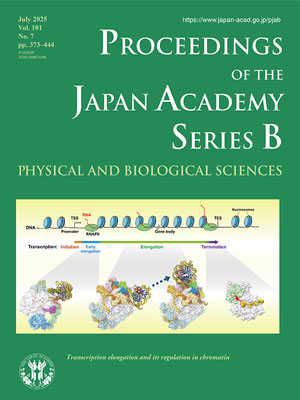About the Cover
Vol. 101 No. 7 (2025)
Transcription is the first step of gene expression and is essential for all biological processes. In eukaryotes, RNA polymerase II (RNAPII) plays a central role by transcribing all protein-coding genes and many non-coding RNAs. During this process, RNAPII dynamically interacts with numerous accessory factors to execute and regulate transcription within the chromatin environment. Although nucleosomes, the fundamental units of chromatin, pose physical barriers to RNAPII, it can somehow traverse them while maintaining their structure. By leveraging recent advances in cryo-electron microscopy (cryo-EM), Sekine and colleagues conducted extensive structural studies capturing snapshots of RNAPII progressing through chromatin, providing key mechanistic insights into RNAPII-mediated transcription, as highlighted in the review in this issue (pp. 414–430). The cover art offers a clear and organized depiction of the mechanism discovered by the authors, illustrating transcription elongation complexes (ECs) involved in promoter-proximal pausing (lower left), nucleosome transcription (lower center), and transcription termination (lower right), as detailed below.
In metazoan gene expression, RNAPII often stalls 20–60 bp downstream of the transcription start site (TSS), demonstrating a regulatory phenomenon known as promoter-proximal pausing. This process, which is essential for gene regulation, development, and disease, is governed by two pausing factors, NELF and DSIF, as well as the first nucleosome immediately downstream of the TSS (the +1 nucleosome). Together with elongation factor TFIIS, they form a paused elongation complex (PEC2-nuc, lower left), stabilizing RNAPII until pause release. Following pause release, RNAPII assembles a processive EC with elongation factors such as Spt4/5, Elf1, Spt6, Spn1, Paf1C, and TFIIS, enabling transcription through chromatin (lower center). To traverse the nucleosomes, the EC temporarily disassembles the downstream nucleosome, transfers histones upstream of the EC with the help of the histone chaperone FACT and reassembles the nucleosomes. Sekine and colleagues uncovered this histone recycling mechanism, revealing how chromatin structure and epigenetic marks are maintained during transcription. At gene ends, transcription must be terminated by releasing the RNA product and dislodging the RNAPII from the DNA. In eukaryotes, this involves cleavage and polyadenylation (CPA) of pre-mRNA near the poly(A) signal. The exonuclease Rat1/Xm2 then degrades the remaining nascent RNA from its 5´ end, catching up to and displacing RNAPII from the DNA, a mechanism known as “torpedo” termination (lower right). Sekine and colleagues reported multiple intermediate structures of RNAPII bound to the Rat1-Rai1-Rtt103 complex, revealing how the exonuclease engages with the nascent RNA and how it progresses toward RNAPII to trigger termination.
Further structural investigations will illuminate the mechanisms of transcription and its connections to gene regulation, development, and disease.
Hitoshi Kurumizaka
Professor, Institute for Quantitative Biosciences, The University of Tokyo




